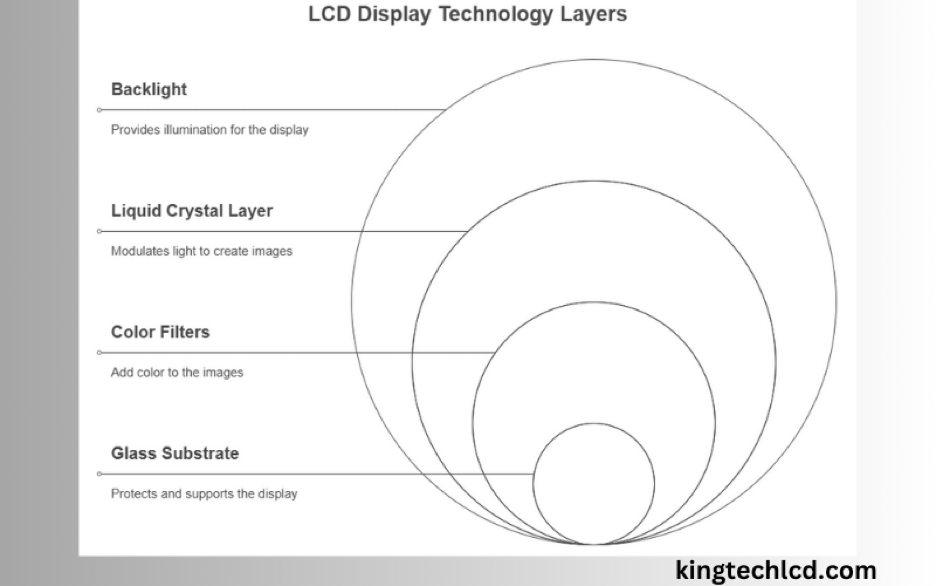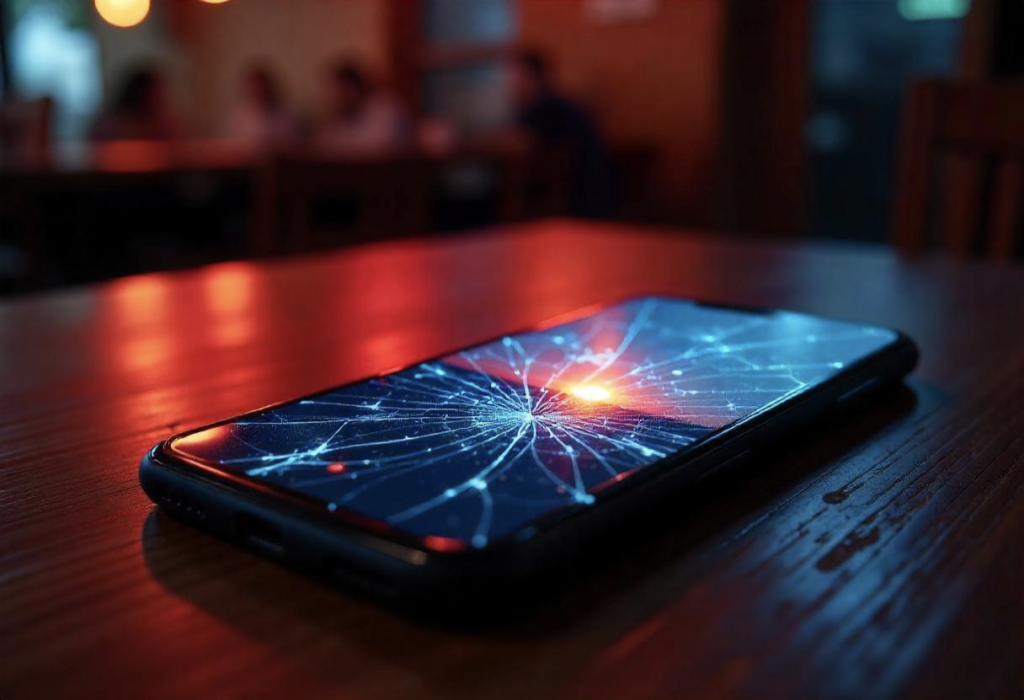Introduction
The display is one of the most important parts of a smartphone. There are various phone display options such as LCD, IPS LCD, OLED, and AMOLED.
Among these displays, LCD( Liquid Crystal Display) is influential for its reliable performance, energy efficiency, and vibrant color reproduction. They are the most affordable display technology widely used in budget smartphones.
This article will explore what is a LCD on a phone, how they work, their types, and their comparison with other phone displays. Let’s get started.

Article Directory:
- Introduction
- What is a LCD on a Phone?
- How Does LCD Display Technology Work?
- What Are the Different Types of LCD Displays Used In Smartphones?
- Comparison of LCD vs. Other Phone Screens
- FAQs
- Conclusion
What is a LCD on a Phone?
LCD is the acronym for Liquid Crystal Display. LCD on a phone means the LCDs used in smartphones. It is a flat-panel display technology that uses the modulating characteristics of liquid crystals with two polarizers to generate images.

How Does LCD Display Technology Work?
The LCD panel works in several stages with different layers of specific functions. The following are the different LCD layers and their functioning in the working process of LCD technology.
Backlight: Backlight technology is the light source that illuminates the liquid crystals. Most modern LCDs use light-emitting diode (LED) for their backlighting. LEDs are energy efficient and provide superior brightness.
Liquid Crystal Layer: The liquid crystal layers are the main part of the LCD. The thin layer of liquid crystals is sandwiched between two glass or plastic plates which are known as polarizers. When an electric voltage is applied to the liquid crystal layer, the orientation of the crystals changes. This change in orientation affects how light passes through the crystals, enabling the LCD to block or allow light to pass through.
These lights enlighten the individual pixels arranged in a grid. Each pixel has red, green, and blue sub-pixels that can be turned on or off.
Color Filters: Color filters add different colors(red, green, and blue) to the images generated by the liquid crystal layer.
Glass Substrate: The entire LCD construction is protected by glass substrates that also assist in displaying high-quality images.

Various LCD technologies for phones are TFT, IPS, and SLCD. Let’s briefly describe these displays.
TFT( Thin Film Transistors) LCD: The TFT is a basic LCD. It uses thin-film transistor technology to improve image quality, response time, and color accuracy. The TFT displays utilize an active matrix structure where each pixel is controlled by one or more transistors. This design ensures faster response times, improved contrast and brightness, and higher resolution.
The key features of TFT LCDs are:
- Active matrix technology
- High refresh rate
- Better color reproduction
- Energy efficiency
- And wide applications
IPS(In-Plane Switching) LCD: The IPS LCD is the most popular display technology in modern high and mid-range smartphones. The liquid crystals are aligned horizontally (in-plane) in IPS LCD for consistent color reproduction, better contrast and brightness, and reduced color shifting and distortion. The main features of the IPS LCD are:
- Wider viewing angles up to 178 degree
- Superior color accuracy
- Better contrast and brightness
- Slower response time than twisted nematic(TN)
- Higher power consumption than TN.
The IPS LCDs have variations in types such as standard IPS, Super IPS(S-IPS), advanced high-performance IPS(AH-IPS), and nano IPS. Each of them has some special properties and features.
Super LCD(SLCD): The super LCD is a special variant of LCD which is a kind of TFT LCD. It was developed as an alternative to AMOLED (Active Matrix Organic Light-Emitting Diode) displays. The SLCD is a sophisticated display for smartphones and tablets.
It improves the efficiency of the traditional LCD by minimizing the air gap between the glass panel and the display layer. It ensures better outdoor visibility, more natural colors, and lower power consumption. The following are the key features of the SLCD:
- The no-air gaps reduce the glare and improve outdoor visibility.
- It generates a better color.
- Consume less power than AMOLED displays.
- Improved contrast creates deeper blacks compared to traditional LCDs.
- Faster response time reduces motion blur.
SLCD was commonly used in HTC smartphones, but modern devices utilize AMOLED or advanced IPS LCDs.
Thee are the LCDs used in different smartphones. I expect you to understand ‘ what is an LCD on a phone’. Now let’s see the comparison of LCD for phones with other display technology.
Comparison of LCD vs. Other Phone Screens:
The following broad comparison table will make you more knowledgeable about the context of ‘what is an LCD on a phone’.
| Feature | LCD (TFT/IPS) | Super LCD | AMOLED | OLED | Mini-LED | Micro-LED |
| Display Type | Backlit liquid crystal | Advanced LCD without air gap | Self emissive(organic LEDs) | Self-emissive OLED panel | Backlit(Mini-LED zones) | Self-emissive panels like OLED with better performance |
| Brightness | Moderate | High | High | High | Very High | Extreme |
| Color accuracy | Good | Better than LCD | Vivid color | Excellent | Excellent | Excellent |
| Black Levels | Moderate | Improved | Perfect(true blacks) | Perfect(true blacks | Deep blacks but not like OLED
|
Perfect(true blacks) |
| Contrast Ratio | 1000:1-1500:1 | Higher than LCD | Infinite | Infinite | 1,000,000: 1( much higher than LCD) | Infinite |
| Viewing Angles | Decent | Good | Excellent | Excellent | Excellent | Excellent |
| Energy Efficiency | High | Better than LCD | Efficient during dark images | Same as AMOLED | More efficient than LCD | Best for energy efficiency |
| Outdoor Visibility | Average (Experience glare issues) | Better than LCD | Excellent | Excellent | Very good | Excellent |
| Response Time | 5ms -10ms | Faster than LCD | 1ms-5ms | 1ms-5ms | Fast | Ultra-fast |
| Durability | Highly durable without burn-in issues | Similar to LCD | May experience burn-in issues | Can suffer from burn-in | No- burn-in issues | No- burn-in issues |
| Cost | Low | Medium | High | High | Very High | Extremely High |
| Application | Budget phones and older devices | Mid-range phones, VR, and headsets | Flagship phones | High-end foldable phones | Premium HDR displays in gaming device | Ultra premium devices, AR and VR |

FAQs
The following FAQs on the topic ‘What is an LCD on a phone” will inform you more.
- What happens if the LCD is broken?
Answer: If your LCD is broken, it can experience minor damage to the complete display failure. There may occur two types of breaking in LCD, cracked screen and broken screen.
If the LCD screen is cracked, the outer glass is damaged. You will see cracks as a spiderweb. This broken display may still work but can be hazardous due to sharp edges.
If the LCD screen is completely broken, the liquid crystals will be damaged. It may exhibit the following symptoms:
- Black spots or blotches.
- Lines or distortions.
- Flickering or dim display.
- Color distortions.
- Complete black screen.
- Lack of touchscreen responsiveness.
You must replace the display immediately in case of this type of damage.
- What does a phone LCD do?
Answer: The LCD is the most essential component of the phone. The main function of the display is to represent the information visually. It allows you to see images and text on your mobile devices. LCD carries electrical signals from the phone’s processor and transforms them into visible images and text.
- Which is better AMOLED or LCD?
Answer: AMOLED and LCD are popular display technologies for modern smartphones. AMOLED displays provide better color accuracy, excellent contrast, and energy efficiency while the LCDs are better for their brightness and affordability.
- Is LCD damage permanent?
Answer: Yes, the LCD damage is usually permanent.
- Is LCD screen repairable?
Answer: The repairability of an LCD depends on the severity of damage. If the LCD just has surface scratches or cracked outer glass, it may be repaired. But a completely damaged LCD cannot be repaired, it must be replaced with a new one.
Bottom Line: LCDs have been the basic display technology in smartphones for many years. They offer good image quality, better brightness, and energy efficiency at a reasonable cost. Though some new technology offers superior performance in some cases, LCDs are still a better option for budget-friendly devices.
We hope, now you know what is a LCD on a phone. This knowledge will help you make an informed decision to purchase a smartphone. We hope you enjoyed reading the article and learned some valuable knowledge about the phone display. Visit our blogs regularly to learn more technologies. Thank you.
